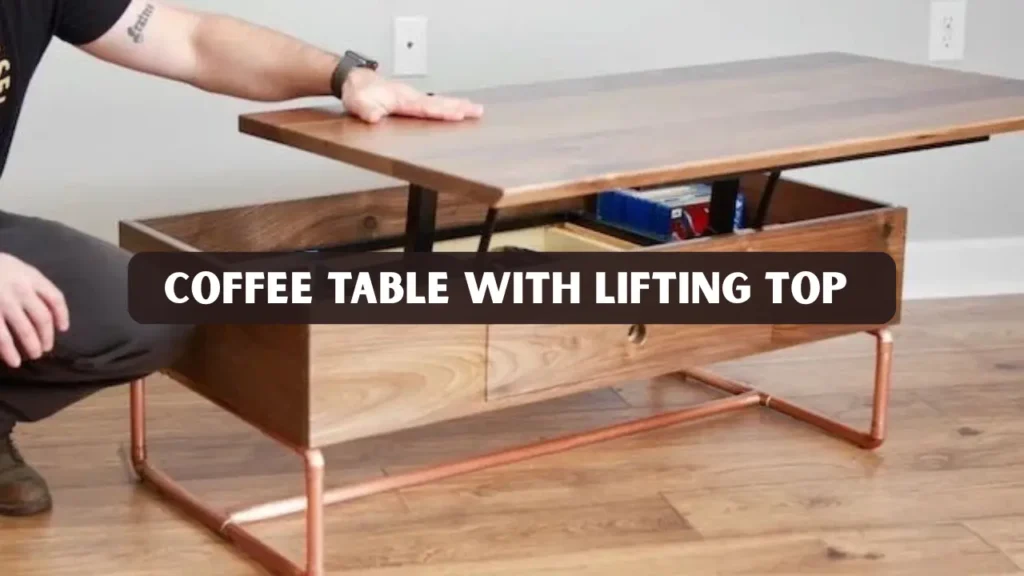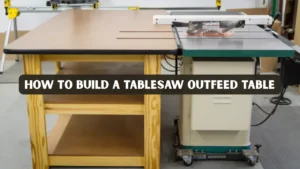Creating a coffee table with lifting top is one of the most rewarding woodworking projects for DIY enthusiasts. This piece of furniture combines design, craftsmanship, and practicality. The lift-top design allows you to raise part of the tabletop to a comfortable height for working on a laptop, eating, or playing games, while revealing hidden storage underneath.
Whether you are upgrading your living room or improving your woodworking skills, this project offers both creativity and function. It allows you to design a centerpiece that complements your interior and reflects your craftsmanship.
The process involves planning, cutting, assembling, installing a lift mechanism, and applying a finish. With the right approach, materials, and attention to detail, you can create a durable and visually appealing piece that will serve your home for years.
Key Takeaways
- A coffee table with lifting top provides both storage and function, transforming an ordinary living room into a versatile workspace or dining area.
- Choosing the right lift mechanism ensures smooth operation and long-term durability.
- Careful planning of joinery and measurements prevents common issues like top misalignment or hinge binding.
- A proper finish adds protection and enhances the wood’s beauty.
- Building one yourself saves money and lets you customize design, size, and storage space.
Why Build a Coffee Table with Lifting Top?
A coffee table with lifting top offers advantages that traditional coffee tables lack. It adds an ergonomic surface for multiple activities and hidden storage for items like books, remotes, and chargers.
Benefits include:
- Multifunctionality: The tabletop doubles as a workspace or mini dining area. It easily transitions between different uses, making it perfect for small apartments or multi-purpose living spaces.
- Hidden Storage: Provides space to declutter your living room. You can neatly store remotes, magazines, or blankets underneath, keeping your surface clean and organized.
- Customization: You can adjust size, material, and finish to suit your décor. This flexibility allows you to match the table with both modern and rustic interiors.
- Durability: Solid joinery ensures longevity compared to store-bought tables. With proper sealing and care, it can withstand daily use for many years without losing its charm.
- Cost Efficiency: Building it yourself costs less than buying a high-end version. You also gain the satisfaction of creating a custom furniture piece with your own craftsmanship.
The popularity of lift-top coffee tables continues to grow among homeowners who appreciate both style and utility.
Planning and Design
The planning phase determines the success of your build. Start by measuring your available space and sketching your table design. Decide the table’s dimensions, height of lift, and storage depth.
Decide the Table Function
Think about how you will use your table with lifting top. If you plan to work on it, ensure the lifted surface reaches a comfortable sitting height. If you prefer storage, design a deeper compartment.
Mechanism Selection
Choosing the right mechanism is crucial for stability and motion. There are three main options:
- Spring Hinge Mechanism: Ideal for lightweight tops, easy to install, and affordable. It’s perfect for DIY beginners who want a reliable lift system without complex tools.
- Gas Strut Mechanism: Offers smooth lifting and adjustable pressure. This mechanism provides a premium feel and allows effortless opening and closing with minimal force.
- Scissor Lift Frame: Provides balanced movement for heavier tops but costs more. It ensures long-term stability and precision, making it suitable for large or solid wood tabletops.
Check load ratings and ensure the hardware supports the tabletop weight. Testing before final assembly helps avoid operational issues later.
Materials and Tools
Materials
- Solid wood or plywood (oak, maple, walnut, or birch)
- Lift-top mechanism
- Screws, bolts, and brackets
- Wood glue and filler
- Sandpaper (120, 180, 220 grit)
- Wood finish (polyurethane, lacquer, or oil)
- Hinges and handles (if needed)
Tools
- Table saw or circular saw
- Drill and driver
- Router with straight bit
- Measuring tape and square
- Clamps
- Sander or sanding block
Having all materials ready ensures smooth workflow and accurate assembly.
Building the Frame
Step 1: Cut and Prepare Pieces
Measure and cut your lumber to the planned dimensions. Label each piece to prevent confusion during assembly. Dry-fit all components before gluing.
Step 2: Assemble the Storage Box
Join the front, back, and side panels using pocket holes or dowels. Ensure all corners are square. Insert the bottom panel into dado grooves or attach it using screws and glue. This box will form the main storage compartment beneath the lifting top.
Step 3: Reinforce the Structure
Add internal cleats or braces along the edges to increase strength. Reinforcement is especially important for tables with solid hardwood tops to prevent sagging over time.
Installing the Lift Mechanism
Step 1: Mark Mounting Points
Place the mechanism inside the storage box and mark where each bracket will attach. Check that the mechanism’s travel path is clear and that the tabletop will open without hitting the frame.
Step 2: Attach to the Base
Secure the lower section of the mechanism to the side panels with screws. Do not fully tighten until you confirm smooth motion.
Step 3: Attach the Tabletop
Position the tabletop and attach it to the upper brackets of the lift mechanism. Slowly lift and lower the top to ensure smooth action. Adjust as necessary before tightening all screws.
Step 4: Test the Motion
Test several times to confirm stability. A correctly installed mechanism will lift evenly and hold in place without wobbling.
Sanding and Finishing
After assembly, sand the entire table thoroughly. Start with 120-grit paper and progress to 220-grit for a smooth finish. Wipe away all dust before applying the finish.
Finishing options:
- Oil Finish: Brings out the natural wood color. It penetrates deep into the grain, giving the table a warm, rich look and enhancing its natural texture.
- Polyurethane: Adds a durable, glossy coating. This finish protects against scratches, heat, and moisture, making it ideal for high-use furniture like coffee tables.
- Lacquer: Provides a professional, smooth surface. It dries quickly and gives a polished appearance, perfect for achieving a sleek, modern finish.
Apply multiple coats for protection, sanding lightly between coats for best results.
Aesthetic Enhancements
Adding decorative touches enhances your table with lifting top. Consider these options:
- Edge Profiles: Use a router to round or bevel edges for a refined look. Smooth edges not only enhance aesthetics but also make the table safer by reducing sharp corners.
- Inlays: Add metal or contrasting wood inlays for visual appeal. They create a custom, high-end appearance that reflects craftsmanship and attention to detail.
- Leg Styles: Choose tapered, turned, or hairpin legs to match your room’s design. The leg choice can completely transform the table’s personality from rustic to modern.
- Paint or Stain: Paint provides color variety, while stain highlights the natural wood grain. Each option allows you to personalize the piece, ensuring it fits seamlessly into your home décor.
These customizations help your table stand out and complement your home décor.
Common Mistakes to Avoid
- Incorrect Measurements: Even small errors affect lift mechanism alignment. Always double-check dimensions with a square and measuring tape to ensure perfect fitting during assembly.
- Skipping Dry-Fit Tests: Always test assemblies before applying glue. This step helps identify any gaps or alignment issues early, saving time and preventing costly mistakes.
- Using Weak Hardware: Low-quality screws or hinges may loosen over time. Invest in heavy-duty hardware to ensure your lift-top table remains sturdy and functional for years.
- Ignoring Finish Prep: Failing to sand properly leads to uneven finishes. Proper sanding smooths out imperfections and helps the finish adhere better for a polished, professional result.
- Poor Mechanism Placement: Misalignment causes binding or uneven lifting. Carefully follow your lift kit’s manual to position the mechanism at the correct height and distance for smooth operation.
Avoiding these mistakes ensures your table functions smoothly and lasts for years.
Cost and Time Estimate
- Lumber: $80–$250 depending on wood type. Choosing higher-quality hardwoods may increase cost but results in a more durable and visually appealing table.
- Lift Mechanism: $40–$150. Investing in a reliable mechanism ensures smooth lifting action and long-term functionality.
- Hardware and Finish: $30–$70. Quality screws, hinges, and finishes protect your investment and enhance the overall appearance of the table.
- Total: Around $150–$470. Building it yourself provides a custom, functional piece at a fraction of the cost of store-bought designer tables.
Building this project may take 2–4 days, depending on your skill level and drying time for finishes.
Real-World Example
One homeowner built a modern coffee table with lifting top using walnut plywood and a scissor lift mechanism. The total cost was under $300, and the final product looked like a store-bought designer piece. The builder noted that pre-fitting the lift hardware before final assembly prevented alignment issues and saved hours of rework.
Such examples show how attention to planning and quality materials lead to professional results.
Design Variations
- Dual-Lift Top: Two separate sections that lift independently. This design allows multiple users to access storage or use the table simultaneously without interference.
- Rustic Style: Use reclaimed wood with a matte finish for a farmhouse appearance. It adds character and warmth, giving your living space a cozy, vintage feel.
- Modern Minimalist: Sleek straight lines and metal legs create a contemporary vibe. This style emphasizes simplicity and elegance, making the table a subtle yet striking focal point.
- Compact Version: Ideal for small apartments or offices with limited space. Despite its smaller footprint, it still provides functional storage and lift-top usability without overcrowding the room.
Each variation allows you to personalize the build according to your needs and taste.
Maintenance Tips
- Wipe the surface regularly with a damp cloth. This prevents dust and dirt from scratching the finish and keeps the table looking clean and polished.
- Reapply finish every few years to preserve appearance. Regular refinishing also protects the wood from moisture, wear, and fading over time.
- Tighten screws occasionally to maintain stability. Checking hardware periodically ensures that the lift mechanism continues to operate smoothly and safely.
- Avoid placing hot items directly on the surface. Using coasters or trivets protects the finish and prevents heat damage or discoloration.
Proper maintenance extends the lifespan of your table and keeps the lift mechanism operating smoothly.
Environmental Considerations
Choosing sustainable materials helps protect the environment. Opt for FSC-certified wood or reclaimed lumber. Use low-VOC finishes and water-based sealants to reduce harmful emissions. Responsible material selection ensures beauty without environmental compromise.
Conclusion
A coffee table with lifting top is a perfect blend of form and function. It enhances living spaces, provides practical storage, and showcases craftsmanship. With careful planning, quality materials, and the right lift mechanism, you can build a table that reflects your personal style while serving your everyday needs.
Before beginning, review measurements, test hardware, and focus on safety. Each phase; cutting, assembling, sanding, and finishing plays a crucial role in the project’s success
Building a lift-top coffee table is more than a project, it’s an achievement that combines skill, creativity, and lasting value for your home.
FAQs
How much weight can a lift-top coffee table support?
Most lift mechanisms handle between 50 to 200 pounds, depending on material and design. Always check the hardware’s weight rating before installation.
Can I convert my existing coffee table into a lift-top model?
Yes, you can retrofit an existing table by replacing the top and adding a compatible lift mechanism. Ensure the base structure can handle additional stress.
What is the ideal height for a table with lifting top?
The ideal lift height is between 24 and 30 inches from the floor, providing a comfortable level for working or eating.
How can I make the lift motion smoother?
Lubricate moving joints and use a balanced mechanism that supports both ends evenly. Gas struts typically provide the smoothest lift.
Is it safe to build one without experience?
Yes, as long as you follow instructions, measure carefully, and use appropriate tools. Beginners should start with simple designs before attempting advanced joinery.




